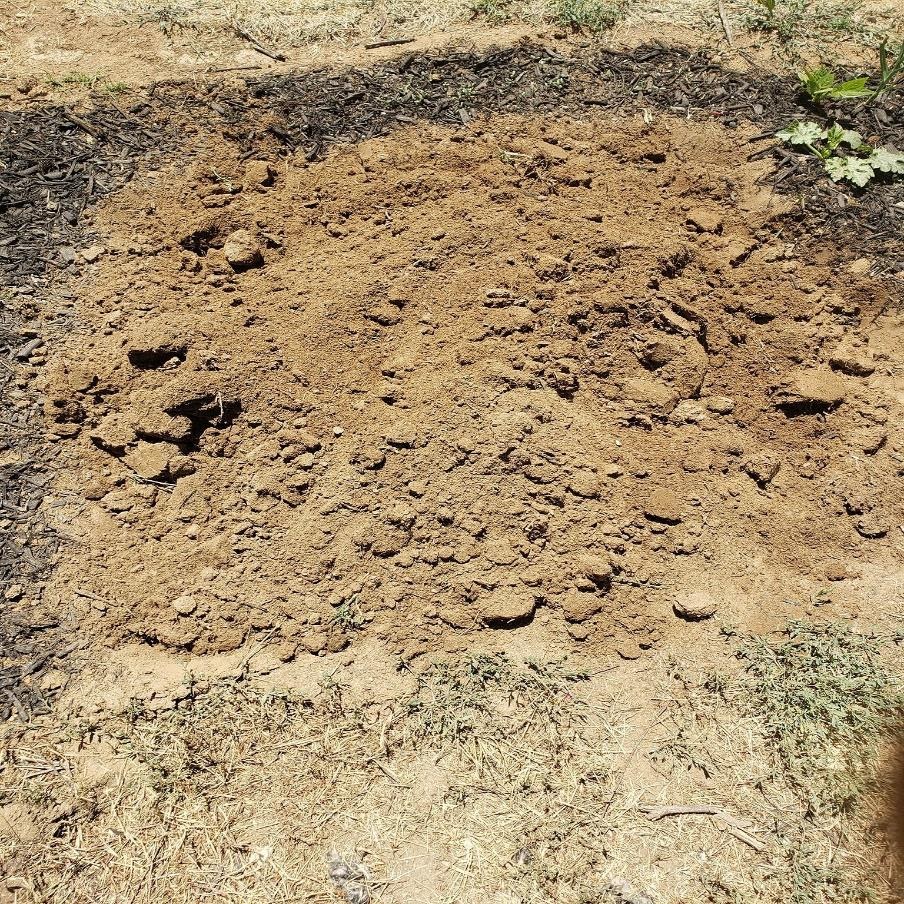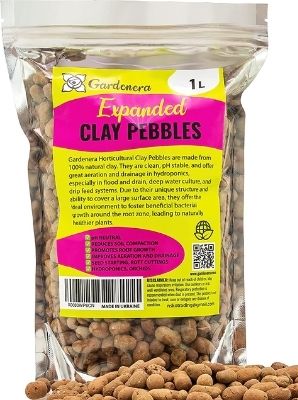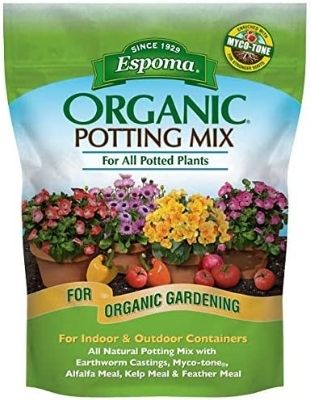Table of Contents
2 Common Types of Garden Soil
First, let’s discuss the two most common types of soil found on most landscapes:
- Sandy Soil
- Clay Soil
Certain crops can grow in both types of soil. But if you want your crops to thrive, just know that most prefer crumbly, organically rich soil packed with microbes, earthworms and other soil life.
If you have clay-like or sandy soil, it’s best to amend it with compost. Shredded leaves, grass clippings and other soil builders help bring life to the soil. This gradually improves the soil’s quality, making it more and more productive over time.
1. Sandy Soil
Sandy soil is known for allowing the plant roots to get lots of air. However, it drains really fast, so the plants may get depleted of nutrients and moisture. To enhance sandy-like soil, add some peat moss and compost regularly.
2. Clay Soil
Clay soil actually holds onto moisture really well. Some might say it holds it too well for the plants to thrive. The soil’s particles are very fine, which causes them to stick to each other.
This stops the soil from draining properly and keeps the air from getting to the plant roots. Adding peat moss, gypsum and compost regularly will improve the soil’s quality.
Get a Soil Test
Not quite sure which type of soil is on your landscape? Check out this soil quick squeeze test from the Orange County, California Master Gardeners.

We have horribly dense, dry, compacted native soil here in Moreno Valley.
The Best Gardening Soil for In-Ground Gardens
Quick Fix: Organic Potting Soil
For in-ground gardens, one of the best soils you can use when you need a quick fix is organic potting soil. Four of its benefits include:
- Contains an abundance of nutrients
- Absorbs water effectively
- Has a loamy texture
- Adds healthy soil to your native dirt
This is the quickest way to start an in-ground garden using good, quality soil. Just fork, spade or rake it into your native soil a bit. Make sure to add at least six inches of new soil on top of your native soil because plants need that much to develop healthy roots.
Note: This is just a quick fix. For the best results, you need to build your soil using composted materials.
Using Chemical Fertilizers
Homes are built on dirt. And the builders do a lot of tilling to build those homes. They also scrape all the topsoil away to install foundations, pipes and things like that. Whatever dirt remains after all the construction is complete becomes the new topsoil.
Instead of amending it, the landscapers come in and roll out the fresh, new lawns right on top of it. They plant trees and shrubs, giving everything large doses of chemically infested fertilizers. This gives the greenery an instant boost of energy. However, this also leaves the dirt depleted of organic matter.
Although chemical fertilizers do provide instant gratification, they don’t provide the long-term nutrition plants need to flourish. It’s almost like buying a burger and wondering why you’re still hungry. When you could’ve eaten a steak, potatoes and some veggies and been full until the next day.
Feed the Soil, Not the Plant
This is an age-old saying that Master Gardeners live by here in the U.S. Most of the soil we find in our home landscapes is compacted and starving for nutrition. This makes it less soil and more just plain old dirt.
So, the key is to concentrate on feeding the soil instead of the plants themselves. That way, your soil is organically rich over time, giving you a better crop each and every year. This is done by continuously amending the soil by adding rich, organic matter.
Soon, your crappy dirt will come to life as the amendments continue to decompose. It will attract earthworms and other beneficial bugs, which will help the decomposition process, creating the beneficial nutrients, fungi and bacteria that the plants need to thrive.
Making Sandy Soil Loamy
Here are just six types of organic amendments that help to improve the soil includes:
- Compost
- Seaweed
- Coconut Fiber
- Worm Castings
- Aged Manure
- Organic Fertilizers – Slow-release and liquid soluble
Benefits of Amendments for Sandy and Loamy Soils
All of these amendments help improve the soil’s texture over time:
- They transform sandy soil into loamy soil, while helping it hold onto nutrients and moisture
- For clay soil, drainage improves, so water seeps into the ground instead of creating pools above the ground
No matter which type of soil you have, adding organic amendments will eventually solve all of your soil issues. It helps the soil fight against too much alkaline or high pH levels and many other deficiencies. High-quality compost will give your plants everything they need, so you’ll never find yourself worrying about pH.
Peat Moss vs Coco Coir
Many gardeners add peat moss to their soil because it helps with moisture retention and drainage. However, peat moss tends to dry out faster than coconut coir. And when it does, it starts repelling nutrients and water. So, it needs watering much more often.
Coco Coir, on the other hand, is known for soaking up moisture. However, since the 2020 issues, it can be hard to find on the market. So, if you have to use peat, put it at the bottom of the hole instead of as a topsoil. Then, try to find coconut coir and add it on top to keep the soil moist.
5 Reasons Why I Moved from In-Ground to Raised Beds
When I first started my garden here in March 2020, I tilled the soil and just started planting. In my haste to get growing as soon as possible, I went the old-fashioned route that I knew best. Growing up in the 70s, that’s how it was always done in my family.
But in time, I realized that there were a few things wrong with this method:
1. Tilling Is Bad for the Land
This process is bad for the soil. If you don’t believe me, check out the Netflix documentary called Kiss the Ground. It’s actually the cause of the Great Dust Bowl which greatly impacted the Great Depression.

Tilling just takes the crappy soil at the bottom and moves it to the top.
2. Bad Moisture Control
Growing in-ground caused a lot of issues with water runoff. I would turn on the soaker hoses in the morning and come back out to find puddles of water on the soil. There would also be a lot of water running off into other areas. What a waste!
3. Bad Soil Control
During heavy winds – and we get blows from the Santa Ana winds a lot here – my dirt would get tossed around all over the yard. I could visibly see the winds moving it around before I could get out there and water it.
4. Bad Pest Control
I had very few pests last year because it was our first year gardening on this land. Nothing had been grown here in at least 10 years. The little birdies were just realizing that I was cultivating the land and had yet to spread the word. Plus, I grew a plethora of marigolds.
But the few pests we did have only bothered the in-ground beds. They never bothered my containers. So, I put my mind in gear and realized that raising the bed up would help a lot.
5. Horrible Dirt
Here in Moreno Valley, California Zone 9B, we have very crappy soil. It’s not quite clay-like, but it’s very hard and dense. I’m not even sure how my cucumbers and squash thrived. But my beans and potatoes sure hated it.
Soon, I realized that I needed to build new soil. And the best way to do that was to build a raised bed. So, that’s exactly what we did.
The Best Gardening Soil for Raised Garden Beds
One of the greatest advantages to growing in raised garden beds is taking control over your gardening soil. It’s a very effective method for gardeners with pollutant concerns, tree root issues or horrible-quality dirt.
There are many different types of soil you can purchase for raised bed gardens. Here are two popular types:
- Triple Mix – Consists of black loam or peat moss, plus compost and topsoil
- 50/50 Mix – Contains one-half compost and one-half topsoil
It’s important to know the source of your topsoil when purchasing it from a retailer. Oftentimes, it comes from land where construction is taking place to develop new housing communities. As noted above, this dirt is full of chemical fertilizers and/or it has no nutrients whatsoever.
Amending Your Raised Bed Soil
Basically, you can use any type of organic soil you choose – preferably NOT Miracle-Gro) – as long as you amend it with rich, organic material. Making your own compost is the best choice. But for many, that’s not an option.
Check out this step-by-step guide to making your own compost brought to you by Better Homes and Gardens.
If not, you can always purchase aged manure and premium compost from your local nursery – NOT the big box stores. Your local nursery will have organic amendments that are locally sourced.
This is important because the best gardening soil is soil that’s native to your area. Be sure to take your bed measurements with you, so they can help you determine how much you need.
Premium composts generally contain an abundance of beneficial fungi and other organic materials designed to produce strong, healthy roots. Experts suggest that they should make up no less than 30% of your gardening space.
How to Add Amendments to the Soil
This is simple. Here are the steps:
- Spread the amendments evenly onto the bed
- Fork and spade them into the native soil, if applicable, or into the bed itself
- Water it in well
- Wait two weeks
- Start planting
Why do you need to wait two weeks before sowing seeds or transplanting plants and seedlings? Well, organic matter tends to make the soil hot… too hot for plants to survive. Watering gets this process going. In about two weeks, the soil will cool back down. Then, you can plant your crops without worrying about the hot soil burning their roots.
Don’t Forget to Mulch
Mulching your garden is very important. When sowing seeds, just know that some mulches can block seedlings from emerging. So, wait until they sprout to mulch unless you’re using something lightweight, such as straw.
After they emerge and after transplanting seedlings and plants, you need to install organic mulch around the base of the plants. Mulch has multiple benefits:
- Watering – Helps retain moisture
- Weeding – Helps suppress weeds
- Soil – Helps protect the naked soil from the blazing hot sun
- Foliage – Keeps the soil from splattering onto the plants’ leaves during watering or rains
- Compost – Organic mulch breaks down over time and becomes even more compost for the soil
2 Cheap Types of Gardening Mulch
Not trying to spend a bundle on garden mulch? Well, here are two very cost-efficient choices:
Leaves and Bark – Make great ground covers, except for the three below:
Do Not Use Walnut Leaves – They can be toxic to various types of plants
Do Not Use Eucalyptus – Inefficient as an organic mulch because it takes entirely too long to decompose
Do Not Use Sawdust – This wood product sucks up the soil’s nitrogen
Coffee Grounds – Just spread them thinly around the plants, no more than ½-inch deep
Recent Articles

















